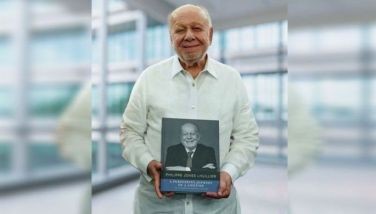The ICANN meetings
December 28, 2001 | 12:00am
So much has been said about the Internet being a network of networks with no central administration. While this statement is largely correct, a closer look reveals that there is an organization which may be considered a "center" and which plays a "central" role in the Internet’s operation.
The Internet Corporation for Assigned Names and Numbers (ICANN) is a private, non-profit corporation which was created in 1998. It was created at the request of the US Department of Commerce for the purpose of privatizing control of the Domain Name System (DNS), the address system that the Internet uses to operate.
Before the creation of ICANN, the "regulation" of the Internet was under the control of the United States government. The Internet Assigned Numbers Authority, under Jon Postel, managed the addressing system from the 1980s to the 1990s.
In 1992, the National Science Foundation and Networks Solutions Inc. (NSI) worked together to coordinate numerical addresses (for example, 23.43.76.01) with text addresses (for instance, e-legal.net.ph). The NSI then began to regulate the assignment of text addresses and charge fees for such a service.
In 1998, the US government decided to do away with NSI’s monopoly over this service and thus, created ICANN. Under ICANN, many companies were allowed to act as registrars of the DNS database and to compete with each other.
ICANN, which is registered in California, is under contract with the US Department of Commerce to perform the following functions: domain name system management, allocation of IP address space, reconciliation protocol number assignment, and maintenance of the root server system functions.
ICANN, as a non-profit corporation, is governed by a 19-member board of directors. One seat is occupied by the president/chief executive officer. Nine seats are held by board members appointed or chosen by ICANN’s supporting organizations, namely, the Domain Name Supporting Organization (DNSO), the Address Supporting Organization (ASO) and the Protocol Supporting Organization.
The DNSO is composed of constituencies like the Registrar Constituency, the Business Constituency, the Intellectual Property Constituency and the Non-Commercial Domain Name Holders Constituency.
The other nine seats are supposed to be occupied by board members elected "at large" by "members" of ICANN. Indeed, in October 2000, ICANN conducted what probably was the most extensive election ever held in the world. At-large members of ICANN chose five directors representing five geographic regions, four of whom were supposed to have been elected later. This election process though is now under review.
To achieve its goal of developing policy through a private-sector bottom-up, consensus-based process, ICANN conducts public meetings of its supporting organizations and the board in different cities of the world, several times a year. The meetings are generally open to anyone and are conducted transparently. This year, it conducted meetings in Stockholm, Montevideo and Marina del Rey, California.
I was fortunate to have attended the meetings in Montevideo, Uruguay last Sept. 10-13 and the annual meeting held in Marina del Rey, California last Nov. 12-15. I was able to do so through the support of the ICANN Travel Support Program of the Salzburg Seminar (icann.salzburgseminar.org), an organization based in Salzburg, Austria and which is joined in this project by the Ford and Markle foundations.
Montevideo is the capital city of Uruguay. Going there was amazing for me, not only because it was my first time out of the country, but also because Montevideo, like Manila, has a Spanish colonial past. In fact, in Montevideo, a gate which used to be part of a wall which protected the Spaniards from the Portuguese, is one the many historical marvels of the city. The gate easily reminded me of our own Intramuros.
Marina del Rey was also very interesting. The annual meeting of ICANN is usually held there because its offices are located in the area. Marina del Rey prides itself as the "headquarters" of the Internet. But that is not the only thing it is proud of. The place is built around the largest man-made small boat harbor in the world. In fact, the harbor, which is home to over 6,000 pleasure boats and yachts, was just across the hotel where the ICANN meeting was held and provided respite for our weary eyes after the discussions.
After the election of the five at-large directors to the board in 2000, ICANN formed an At-Large Membership Study Committee (ALSC) to review the process of having at-large members and electing nine directors to represent them in the board. In August this year, the committee made available for public comment a draft report which was widely discussed during the September meeting in Montevideo.
The report, among others, recommended that the number of at-large directors be reduced to six from the present nine. (Although, the four have yet to be elected.) The report based this recommendation on the view that the stakeholders of ICANN are the developers, the providers and the users.
It also recommended that for persons to become at-large members and thus participate in the election of at-large ICANN directors, they must hold domain names. This is a departure from the e-mail plus regular mail confirmations requirement used in the 2000 election.
Naturally, the report caused a lot of debate during the Montevideo meetings. Many participants from developing countries felt that the developers-providers-users framework was being used to justify the reduction of directors elected at large and thus, disturbed the present balance.
Many also felt that the qualifying requirement of domain name registration to become an at-large member practically disqualifies many in the developing countries where domain registration is either impossible or unaffordable. Still, in November this year, the ALSC submitted its final report with little modifications from the draft report (www.atlargestudy.org/final_report.shtml).
In the November meeting in Marina del Rey, another participant from the Philippines, Zenaida Ugat, and I joined other participants from Africa, Asia and Eastern Europe in a statement read during the ICANN public meeting and which reads partly as follows:
"We hold the opinion that the allocation of nine Board seats, to be filled by elections by the At-Large Membership, is fundamentally important to maintain the participatory bottom-up structure of ICANN, as originally envisioned.
"To limit the at-Large Membership to domain name holders would – in terms of the economic and regulatory environments in many of our countries – immediately exclude citizens of our countries from participation.
"If a balance of seats between board members elected by Internet users and board members nominated by the Internet suppliers groups is not achieved, the (present) unbalanced composition of the ICANN Board is threatening (and will threaten) the legitimacy of ICANN as a whole."
In relation to this, participants from the Asia-Pacific region met during the November meeting in Marina del Rey to discuss the creation of a regional at-large organization. The first order of business was to determine if there were existing national at-large organizations in each of our countries.
For those with none such as the Philippines, we were asked to initiate moves to create one. The national as well as the regional organization is important so that discussion of at-large membership in ICANN will not be dominated by commercial interests. In the meetings, this was always referred to as "capture."
ICANN is not just an ordinary organization. It is a global self-regulatory structure which governs the Internet. If it fails, Internet governance will easily become the subject of an international agreement between governments which is the last thing many Internet stakeholders want. The Internet has generally been doing fine with little government intervention.
The discussions about recommendations of the At-Large Study Committee Report are crucial in justifying the continued existence in ICANN. As a country, we cannot be left behind in the discussions. We Filipinos cannot just be observers in this. Let us now organize our national at-large organization.
The author is a research assistant of the Information Technology Law Program of the University of the Philippines Law Center’s Institute of International Legal Studies (www.iils.org), and editor of the e-Legal, a bi-monthly publication of the IT Law Program (www.e-legal.net.ph). His e-mail address is [email protected].
The Internet Corporation for Assigned Names and Numbers (ICANN) is a private, non-profit corporation which was created in 1998. It was created at the request of the US Department of Commerce for the purpose of privatizing control of the Domain Name System (DNS), the address system that the Internet uses to operate.
Before the creation of ICANN, the "regulation" of the Internet was under the control of the United States government. The Internet Assigned Numbers Authority, under Jon Postel, managed the addressing system from the 1980s to the 1990s.
In 1992, the National Science Foundation and Networks Solutions Inc. (NSI) worked together to coordinate numerical addresses (for example, 23.43.76.01) with text addresses (for instance, e-legal.net.ph). The NSI then began to regulate the assignment of text addresses and charge fees for such a service.
In 1998, the US government decided to do away with NSI’s monopoly over this service and thus, created ICANN. Under ICANN, many companies were allowed to act as registrars of the DNS database and to compete with each other.
ICANN, which is registered in California, is under contract with the US Department of Commerce to perform the following functions: domain name system management, allocation of IP address space, reconciliation protocol number assignment, and maintenance of the root server system functions.
The DNSO is composed of constituencies like the Registrar Constituency, the Business Constituency, the Intellectual Property Constituency and the Non-Commercial Domain Name Holders Constituency.
The other nine seats are supposed to be occupied by board members elected "at large" by "members" of ICANN. Indeed, in October 2000, ICANN conducted what probably was the most extensive election ever held in the world. At-large members of ICANN chose five directors representing five geographic regions, four of whom were supposed to have been elected later. This election process though is now under review.
To achieve its goal of developing policy through a private-sector bottom-up, consensus-based process, ICANN conducts public meetings of its supporting organizations and the board in different cities of the world, several times a year. The meetings are generally open to anyone and are conducted transparently. This year, it conducted meetings in Stockholm, Montevideo and Marina del Rey, California.
I was fortunate to have attended the meetings in Montevideo, Uruguay last Sept. 10-13 and the annual meeting held in Marina del Rey, California last Nov. 12-15. I was able to do so through the support of the ICANN Travel Support Program of the Salzburg Seminar (icann.salzburgseminar.org), an organization based in Salzburg, Austria and which is joined in this project by the Ford and Markle foundations.
Montevideo is the capital city of Uruguay. Going there was amazing for me, not only because it was my first time out of the country, but also because Montevideo, like Manila, has a Spanish colonial past. In fact, in Montevideo, a gate which used to be part of a wall which protected the Spaniards from the Portuguese, is one the many historical marvels of the city. The gate easily reminded me of our own Intramuros.
Marina del Rey was also very interesting. The annual meeting of ICANN is usually held there because its offices are located in the area. Marina del Rey prides itself as the "headquarters" of the Internet. But that is not the only thing it is proud of. The place is built around the largest man-made small boat harbor in the world. In fact, the harbor, which is home to over 6,000 pleasure boats and yachts, was just across the hotel where the ICANN meeting was held and provided respite for our weary eyes after the discussions.
The report, among others, recommended that the number of at-large directors be reduced to six from the present nine. (Although, the four have yet to be elected.) The report based this recommendation on the view that the stakeholders of ICANN are the developers, the providers and the users.
It also recommended that for persons to become at-large members and thus participate in the election of at-large ICANN directors, they must hold domain names. This is a departure from the e-mail plus regular mail confirmations requirement used in the 2000 election.
Naturally, the report caused a lot of debate during the Montevideo meetings. Many participants from developing countries felt that the developers-providers-users framework was being used to justify the reduction of directors elected at large and thus, disturbed the present balance.
Many also felt that the qualifying requirement of domain name registration to become an at-large member practically disqualifies many in the developing countries where domain registration is either impossible or unaffordable. Still, in November this year, the ALSC submitted its final report with little modifications from the draft report (www.atlargestudy.org/final_report.shtml).
In the November meeting in Marina del Rey, another participant from the Philippines, Zenaida Ugat, and I joined other participants from Africa, Asia and Eastern Europe in a statement read during the ICANN public meeting and which reads partly as follows:
"We hold the opinion that the allocation of nine Board seats, to be filled by elections by the At-Large Membership, is fundamentally important to maintain the participatory bottom-up structure of ICANN, as originally envisioned.
"To limit the at-Large Membership to domain name holders would – in terms of the economic and regulatory environments in many of our countries – immediately exclude citizens of our countries from participation.
"If a balance of seats between board members elected by Internet users and board members nominated by the Internet suppliers groups is not achieved, the (present) unbalanced composition of the ICANN Board is threatening (and will threaten) the legitimacy of ICANN as a whole."
In relation to this, participants from the Asia-Pacific region met during the November meeting in Marina del Rey to discuss the creation of a regional at-large organization. The first order of business was to determine if there were existing national at-large organizations in each of our countries.
For those with none such as the Philippines, we were asked to initiate moves to create one. The national as well as the regional organization is important so that discussion of at-large membership in ICANN will not be dominated by commercial interests. In the meetings, this was always referred to as "capture."
The discussions about recommendations of the At-Large Study Committee Report are crucial in justifying the continued existence in ICANN. As a country, we cannot be left behind in the discussions. We Filipinos cannot just be observers in this. Let us now organize our national at-large organization.
BrandSpace Articles
<
>
- Latest
Latest
Latest
November 11, 2024 - 1:43pm
By EC Toledo | November 11, 2024 - 1:43pm
November 6, 2024 - 7:16pm
November 6, 2024 - 7:16pm
November 6, 2024 - 4:50pm
November 6, 2024 - 4:50pm
November 4, 2024 - 9:12am
November 4, 2024 - 9:12am
November 1, 2024 - 9:00am
By Aian Guanzon | November 1, 2024 - 9:00am
October 31, 2024 - 12:02pm
October 31, 2024 - 12:02pm
Recommended






























